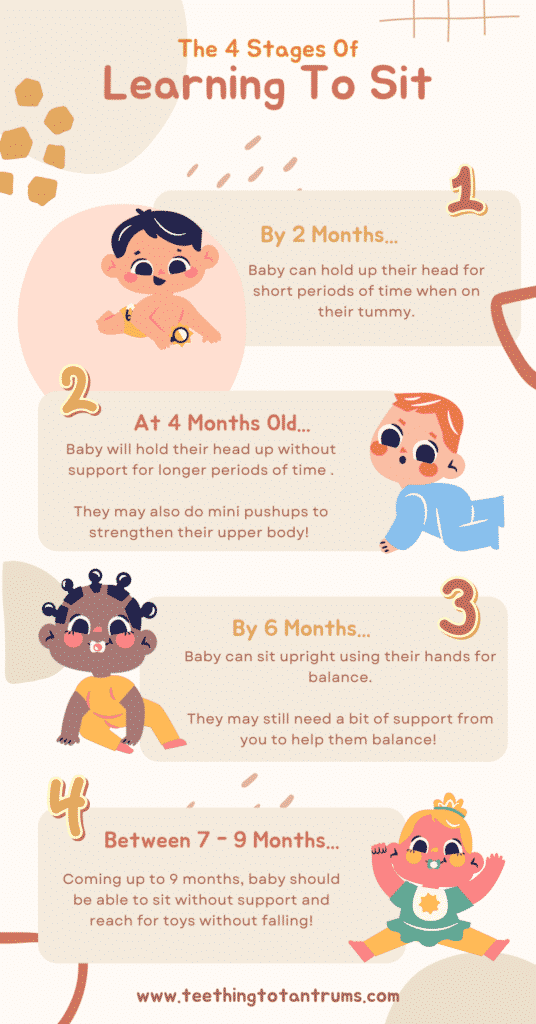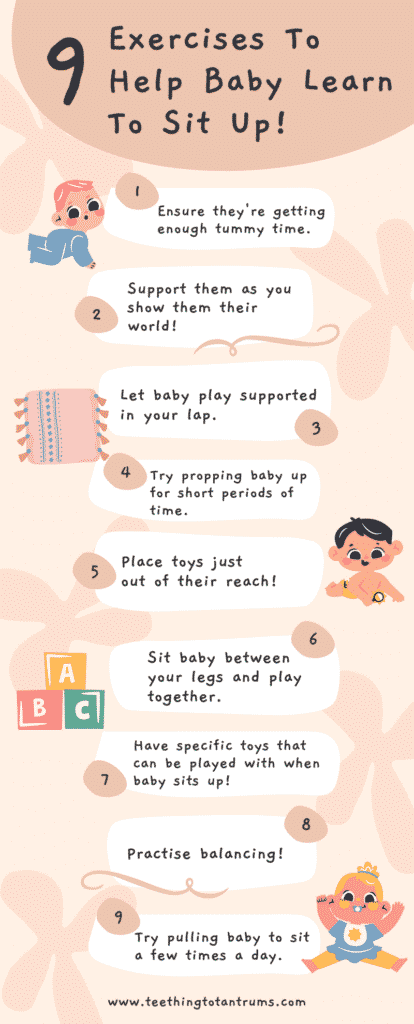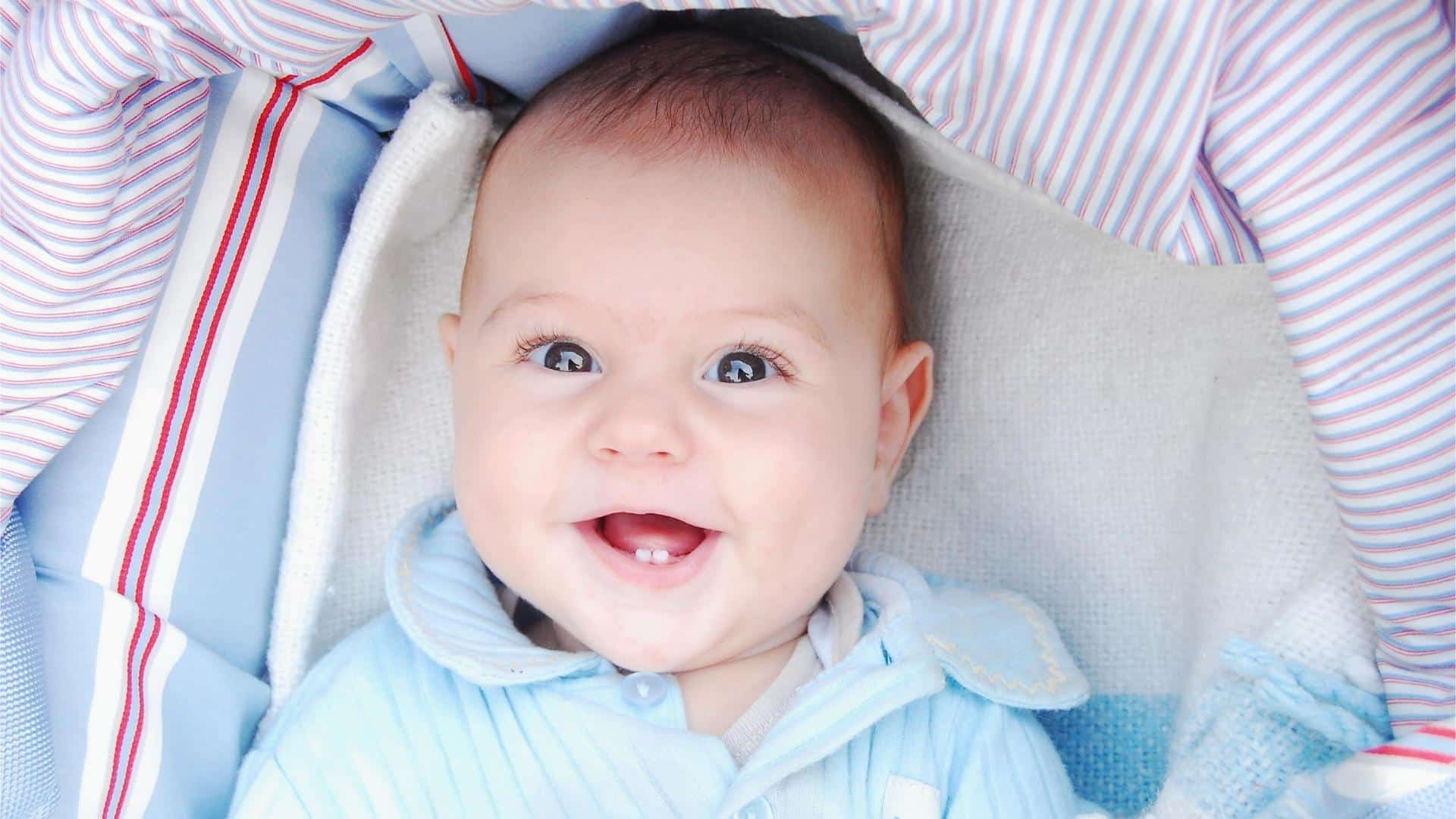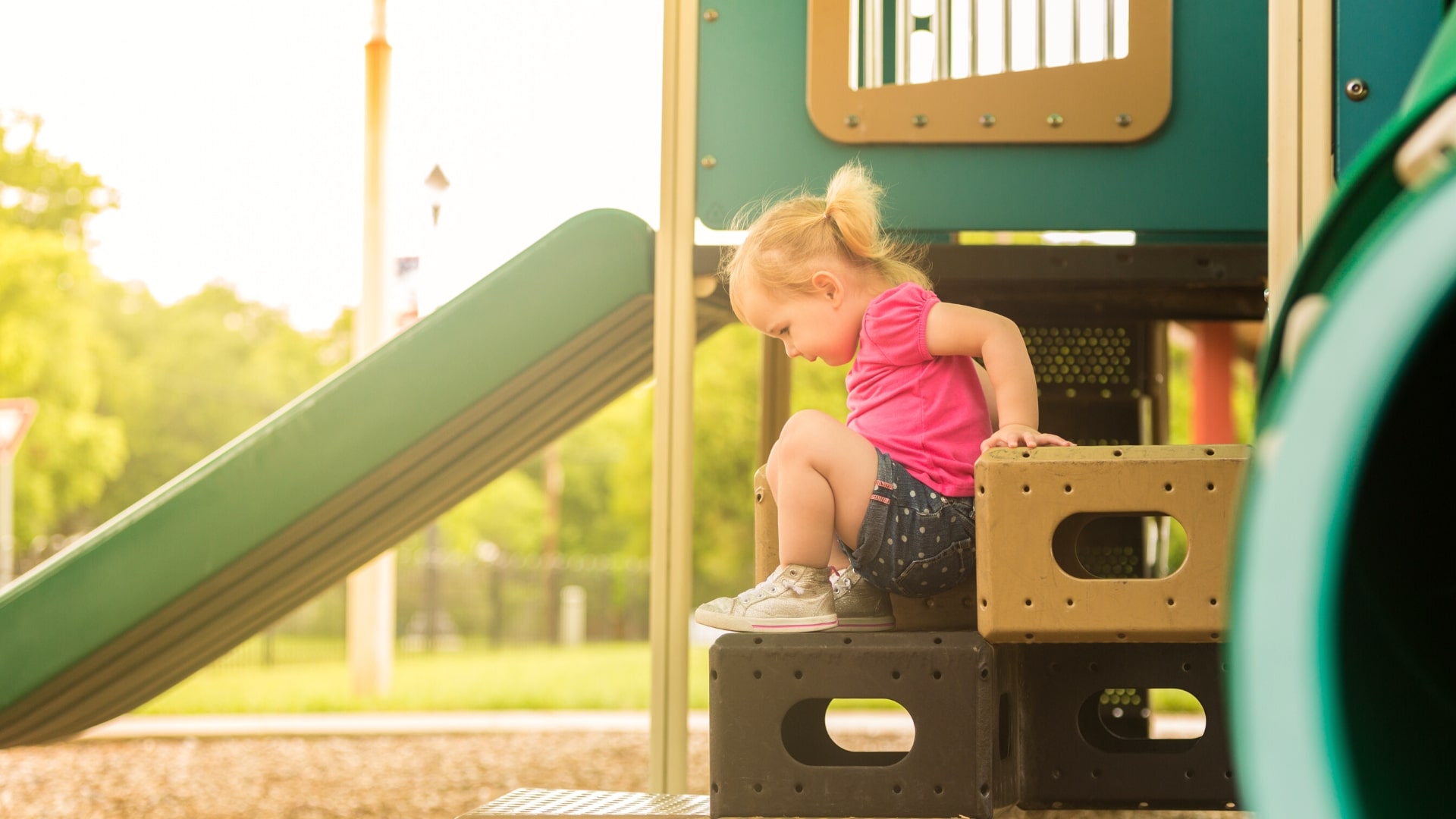Watching your little one hit milestones is an exciting journey! But when do babies start sitting up? What are the stages of learning, and how can you help them master this milestone? Get ready to learn the secrets to helping your little one sit up independently and explore their world like never before.
When Do Babies Start Sitting Up?
Most babies have enough head, neck and upper body strength to be propped up in a sitting position for short periods of time from about 4 months of age. And between 6 and 9 months, your baby will be able to sit up with limited assistance.
What Are The Stages Of Learning To Sit Independently?
The process of learning to sit starts as soon as your baby is born but it is a very gradual process…
Your baby needs to strengthen their neck muscles in order to build head control… And then they need to build up the strength in their upper body, arms and abdominal muscles to balance properly.
So what can we expect from our sitting baby at different months?

Learning To Sit Up At 2 Months
By 2 months old, your baby will be able to hold their head up for short periods of time and look around while lying on their tummy.
Learning To Sit Up At 4 Months
At around 4 months, your baby will be able to hold their head upright and steady for longer periods of time without support.
Your baby will also do mini push-ups during tummy time which will help to strengthen their upper body in preparation for sitting.
Learning To Sit Up At 6 Months
By 6 months, your baby will be able to sit upright using their hands for support, with a straight back and their head up.
They may be able to sit independently for short periods of time but will generally need some sort of support from you.
Learning To Sit Up Between 7 and 9 Months
Coming up to 9 months old, your baby will be able to sit without support and lean and reach for toys easily without falling over.
NOTE: Some babies may even start to push into a sitting position from lying down at this stage too. But don’t worry if they don’t, this can happen anytime between 9 and 12 months.
Looking to get your little one to sleep quickly and effortlessly? Check out my Bedtime and Nap Cheat Sheet and master the art of making daytime naps and bedtimes as seamless as possible.
A bedtime & nap cheat sheet so good your little one will ask you to put them to bed...
Laura Williams "This is a life saver! I'm so glad I downloaded your bedtime & nap cheat sheet. My little one actually asked me to put him to bed last night! Unbelievable! Thank you so much!"
Click Here For The FREE Cheat Sheet
What Are The Best Exercises To Teach Baby To Sit Up?
Babies need to exercise their arms, abdominal muscles, backs, and legs since they use all of these to get into a sitting position or support themselves when sitting.
And there are lots of things that you can do to help teach your baby to sit up by exercising these crucial muscles:

1. Tummy Time
There is no better way for your little one to strengthen those all-important upper body muscles than by doing some tummy time (or floor time) several times per day.
If your little one is struggling with tummy time, check out my post Baby Hates Tummy Time to get them loving it again.
2. Supporting Them As They Explore The World
As well as tummy time, a great way to help baby develop their muscles is to hold your baby in an upright position (with your hand supporting their upper back and neck) and walk around the room so they can twist, bend and generally look around.
3. Playing On Your Lap
Placing baby facing outwards on your lap in a sitting position to show them a fun toy or baby book that they can play with and reach for is a great sitting exercise. It will help them to exercise their upper body and develop some balance in preparation to sit up independently.
4. Propping
There are some great pillows out there that you can use to prop your baby on once they have adequate strength in their upper body and neck.
This Infantino Prop Pillow is a great way to help your baby to learn to sit. Its high back offers lots of support and the bright colours make it interesting for your baby to be around.
REMEMBER: It is important that you do not use these pillows for prolonged periods of time as it’s not good for their development to be in one position for extended periods of time before they’re ready. So, if your baby starts to slough or their back becomes rounded then it is time to change position.
5. Placing Toys Just Out Of Reach
When your baby is propped up, sitting on your lap or between your legs, place some soft toys or blocks to one side slightly out of reach.
This sitting exercise will allow your little one to develop their balance as they reach forward. But make sure you are ready to catch them if they have a little wobble.
These lovely soft blocks from reputable toymakers, Galt, are perfect starting building blocks for your baby. They are easy to stack, soft and safe for young babies to use. Their bright colours will also mean these blocks will never get boring and can be used in a multitude of ways as your baby grows up!
6. Sitting Baby Between Your Legs
Sitting your baby between your legs and helping them play in a sitting position is also a great and safe way to practise sitting.
Be sure to place your hands near baby’s hips rather than under their arms when supporting them as this will ensure they tilt from their base rather than their chest.
7. Use Sitting Toys (they’re not what you think)
Once your baby is on the cusp of sitting independently you can begin to use sitting toys. However, the sitting toys I’m on about are NOT ones that you put your baby in to sit in a position that they are not developmentally ready for.
My sitting toys are ones that your baby can play and engage with while propped in a sitting position such as this LeapFrog Learn and Groove Musical Table.
8. Practise Balancing
Once your baby is well on their way to sitting, place them on a soft play mat in a seated position. Let them wobble and put their hands out to support them.
After all… a little wobbling helps them to learn how to balance while sitting. Just be on hand to ensure they don’t take a big tumble as this may scare them from trying to sit unaided for longer.
This play gym is designed by experts for baby's developing brain and body. Winner of multiple awards it includes everything you need in an activity gym-from batting to teething to learning to focus-for a whole year of play.
9. Pulling Baby To Sit
Once your baby has developed enough strength in their neck muscles and upper body (usually around 6 months of age) you can start pulling your baby to sit by holding their hands and pulling them gently into a sitting position from lying down.
You can then lower them down again and repeat this a couple of times. This is a great way to strengthen your baby’s core muscles.
Here’s a wonderful video from Dr. Jena Bradley showing you How To Teach Baby To Sit Up:
What Milestones Come After Sitting Up?
Once your baby has learnt to sit independently it will not be long before they reach the developmental milestones of:
- Learning to get in and out of the sitting position,
- Learning to crawl,
- Pulling to stand,
- And eventually, walking by their first birthday.
NOTE: Physical development varies baby to baby, so do not be too concerned if your baby is a little slower than others at developing certain motor skills or muscle control. Development is a journey, not a race.
When Do Babies Sit Up From Lying Down?
Some babies will master being able to sit up from lying down as young as 7 months of age… But the majority will not be able to until they are around 11 months of age.
I have written a whole post about when do babies sit up from lying down, so be sure to click here to read the full article… But in case, you just want a quick rundown of how to help your baby reach this milestone, here’s my advice:
- Provide plenty of support for baby
- Stay close and create a soft landing place
- Place toys for reaching
- Don’t stop tummy time
- Have time on their backs too
- Use support or boppy pillows when they’re ready
How To Teach A Baby To Lay Down From Sitting
I have also written a dedicated post all about teaching your baby to lay down from sitting, so click here to check it out. But for a quick 4 step rundown…
- Make sure they have plenty of playtime on their tummy
- Encourage baby to move from sitting to lying down on a soft surface while reaching for a toy
- Avoid putting baby in bouncy seats, pods and swings for daytime sitting
- Practice ‘falling’ by moving baby from sitting to lying down several times a day
Frequently Asked Questions About When Do Babies Start Sitting Up
Looking for more information about when do babies start sitting up? Here are the answers to the most common questions.
Why Can’t My Baby Sit Up By Themselves By 12 Months?
All babies develop at their own rate, but if your baby is not sitting by 12 months of age and you have been offering all the support and plenty of opportunities for your baby to learn to sit…
You should seek medical advice to rule out any underlying developmental issues.
In addition to discussing any concerns about delays in development with your child’s healthcare provider, you can also download a free app by the Centers for Disease Control (CDC) called the Milestone Tracker to help keep track of your little one’s milestones.
When Can Babies Sit Up On Their Own?
Babies do not just suddenly decide to sit up on their own… They spend a lot of time in the early months building up the necessary muscle strength, motor skills and balance to achieve the act of sitting up alone.
Lindsey Garbi, MD, a double board-certified pediatrician, neonatologist, and an active member of the American Academy of Pediatrics says “If placed in the seated position too early, they are likely to fall over because they lack the muscle strength to hold themselves up.” and since each gross motor milestone builds upon the one before it, providing ongoing opportunities for your baby to develop core strength is the best way to help them on their way to sitting.
But by 9 months, most babies will be sitting independently.
What Are The Reasons Why My Baby Can’t Sit Up?
Babies may not learn to sit as expected if they have not been given the opportunities to strengthen the right muscles. Also, they may not be sitting because there is an underlying developmental delay.
If you are at all concerned about your baby’s development, muscle control or feel they are not progressing as expected then you should seek medical advice or reach out to a physical therapist.
Do Baby Bouncers Help Baby Learn To Sit?
Baby bouncers (also known as baby seats and baby swings) will not help your baby to learn to sit. The best way for a baby to learn to sit is by practising the exercises I have mentioned above without artificial support from a bouncer.
After Learning To Sit Up, When Will Baby Start Crawling?
Crawling will normally follow very quickly once your baby has learnt to sit up on their own. I’ve written a dedicated post all about When Do Babies Start Crawling, so be sure to give it a read to know what to expect and learn how to prepare your house.
Need More Parenting Help?
- Download our FREE Bedtime & Nap Sleep Cheat Sheet. It’s a free, easy-to-use and proven formula designed for parents of 0-5 year olds to master the art of consistently undisturbed and restful sleep without the yelling, nagging or exhausting long-winded evenings.
- Check out our Parenting Toolbox. You’ll get access to expertly-chosen products that you can guarantee are the best for your little one and your wallet.
- Are you looking for personalized guidance to navigate the challenges of parenting? I offer 1-on-1 consultations to bring you tailored strategies and actionable advice to help support your child's growth and well-being with confidence.

A bedtime & nap cheat sheet so good your little one will ask you to put them to bed...
Laura Williams "This is a life saver! I'm so glad I downloaded your bedtime & nap cheat sheet. My little one actually asked me to put him to bed last night! Unbelievable! Thank you so much!"
Click Here For The FREE Cheat Sheet






